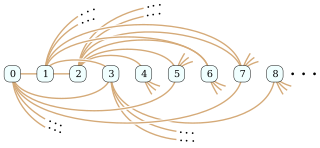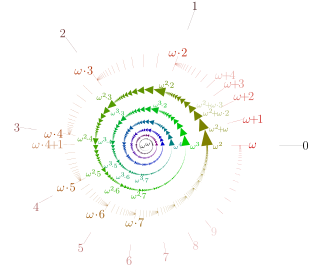Related Research Articles

In mathematics, the axiom of choice, abbreviated AC or AoC, is an axiom of set theory equivalent to the statement that a Cartesian product of a collection of non-empty sets is non-empty. Informally put, the axiom of choice says that given any collection of sets, each containing at least one element, it is possible to construct a new set by arbitrarily choosing one element from each set, even if the collection is infinite. Formally, it states that for every indexed family of nonempty sets, there exists an indexed set such that for every . The axiom of choice was formulated in 1904 by Ernst Zermelo in order to formalize his proof of the well-ordering theorem.

In mathematics, an isomorphism is a structure-preserving mapping between two structures of the same type that can be reversed by an inverse mapping. Two mathematical structures are isomorphic if an isomorphism exists between them. The word isomorphism is derived from the Ancient Greek: ἴσοςisos "equal", and μορφήmorphe "form" or "shape".
In mathematics, a total order or linear order is a partial order in which any two elements are comparable. That is, a total order is a binary relation on some set , which satisfies the following for all and in :
- (reflexive).
- If and then (transitive).
- If and then (antisymmetric).
- or .

In group theory, a branch of abstract algebra in pure mathematics, a cyclic group or monogenous group is a group, denoted Cn, that is generated by a single element. That is, it is a set of invertible elements with a single associative binary operation, and it contains an element g such that every other element of the group may be obtained by repeatedly applying the group operation to g or its inverse. Each element can be written as an integer power of g in multiplicative notation, or as an integer multiple of g in additive notation. This element g is called a generator of the group.
In mathematics, Suslin's problem is a question about totally ordered sets posed by Mikhail Yakovlevich Suslin (1920) and published posthumously. It has been shown to be independent of the standard axiomatic system of set theory known as ZFC; Solovay & Tennenbaum (1971) showed that the statement can neither be proven nor disproven from those axioms, assuming ZF is consistent.
In mathematical logic, a theory is categorical if it has exactly one model. Such a theory can be viewed as defining its model, uniquely characterizing the model's structure.
Finite model theory is a subarea of model theory. Model theory is the branch of logic which deals with the relation between a formal language (syntax) and its interpretations (semantics). Finite model theory is a restriction of model theory to interpretations on finite structures, which have a finite universe.
In mathematics, the Bernoulli scheme or Bernoulli shift is a generalization of the Bernoulli process to more than two possible outcomes. Bernoulli schemes appear naturally in symbolic dynamics, and are thus important in the study of dynamical systems. Many important dynamical systems exhibit a repellor that is the product of the Cantor set and a smooth manifold, and the dynamics on the Cantor set are isomorphic to that of the Bernoulli shift. This is essentially the Markov partition. The term shift is in reference to the shift operator, which may be used to study Bernoulli schemes. The Ornstein isomorphism theorem shows that Bernoulli shifts are isomorphic when their entropy is equal.
In mathematical logic, a non-standard model of arithmetic is a model of first-order Peano arithmetic that contains non-standard numbers. The term standard model of arithmetic refers to the standard natural numbers 0, 1, 2, …. The elements of any model of Peano arithmetic are linearly ordered and possess an initial segment isomorphic to the standard natural numbers. A non-standard model is one that has additional elements outside this initial segment. The construction of such models is due to Thoralf Skolem (1934).
In mathematics, a partial order or total order < on a set is said to be dense if, for all and in for which , there is a in such that . That is, for any two elements, one less than the other, there is another element between them. For total orders this can be simplified to "for any two distinct elements, there is another element between them", since all elements of a total order are comparable.

In the mathematical field of graph theory, the Rado graph, Erdős–Rényi graph, or random graph is a countably infinite graph that can be constructed by choosing independently at random for each pair of its vertices whether to connect the vertices by an edge. The names of this graph honor Richard Rado, Paul Erdős, and Alfréd Rényi, mathematicians who studied it in the early 1960s; it appears even earlier in the work of Wilhelm Ackermann (1937). The Rado graph can also be constructed non-randomly, by symmetrizing the membership relation of the hereditarily finite sets, by applying the BIT predicate to the binary representations of the natural numbers, or as an infinite Paley graph that has edges connecting pairs of prime numbers congruent to 1 mod 4 that are quadratic residues modulo each other.
A timeline of mathematical logic; see also history of logic.
In the mathematical field of order theory, an order isomorphism is a special kind of monotone function that constitutes a suitable notion of isomorphism for partially ordered sets (posets). Whenever two posets are order isomorphic, they can be considered to be "essentially the same" in the sense that either of the orders can be obtained from the other just by renaming of elements. Two strictly weaker notions that relate to order isomorphisms are order embeddings and Galois connections.

In set theory, an ordinal number, or ordinal, is a generalization of ordinal numerals aimed to extend enumeration to infinite sets.
In mathematical logic, an omega-categorical theory is a theory that has exactly one countably infinite model up to isomorphism. Omega-categoricity is the special case κ = = ω of κ-categoricity, and omega-categorical theories are also referred to as ω-categorical. The notion is most important for countable first-order theories.
This is a glossary of set theory.
Cantor's theorem is a fundamental result in mathematical set theory.
In mathematical logic, specifically in the discipline of model theory, the Fraïssé limit is a method used to construct (infinite) mathematical structures from their (finite) substructures. It is a special example of the more general concept of a direct limit in a category. The technique was developed in the 1950s by its namesake, French logician Roland Fraïssé.
In order theory and model theory, branches of mathematics, Cantor's isomorphism theorem states that every two countable dense unbounded linear orders are order-isomorphic. For instance, Minkowski's question-mark function produces an isomorphism between the numerical ordering of the rational numbers and the numerical ordering of the dyadic rationals.
References
- ↑ Silver, Charles L. (1994), "Who invented Cantor's back-and-forth argument?", Modern Logic, 4 (1): 74–78, MR 1253680
- Hausdorff, F. (1914), Grundzüge der Mengenlehre
- Hodges, Wilfrid (1993), Model theory , Cambridge University Press, ISBN 978-0-521-30442-9
- Huntington, E. V. (1904), The continuum and other types of serial order, with an introduction to Cantor's transfinite numbers, Harvard University Press
- Marker, David (2002), Model Theory: An Introduction, Graduate Texts in Mathematics, Berlin, New York: Springer-Verlag, ISBN 978-0-387-98760-6